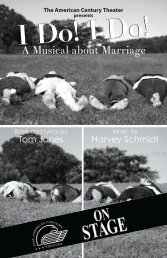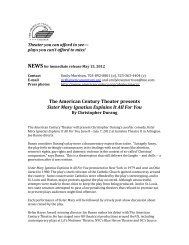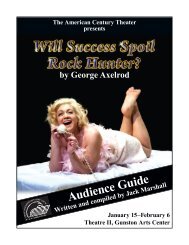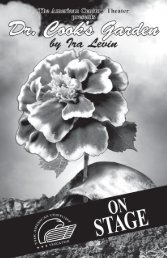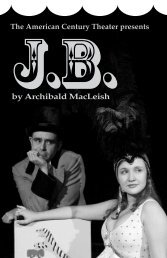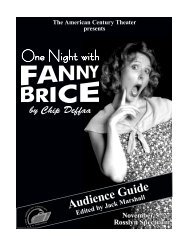Stage Door - The American Century Theater
Stage Door - The American Century Theater
Stage Door - The American Century Theater
Create successful ePaper yourself
Turn your PDF publications into a flip-book with our unique Google optimized e-Paper software.
performed a repertory, in 77 cities and towns, of Cornell’s greatest hits: <strong>The</strong><br />
Barretts, Candid, and Romeo and Juliet.<br />
She was famous as a trouper of the “old school.” One Christmas Day, the<br />
troupe was on its way from Montana to Seattle for a week’s engagement<br />
opening that evening. Floods delayed the train, and at curtain time the actors<br />
were far from Seattle and resigned to missing the performance—and their<br />
pay for it. When the train finally arrived at 11:15 p.m., and Cornell<br />
discovered that the audience was still waiting, she decreed that the show<br />
should go on, and the curtain rose to a cheering throng at 1:05 a.m.<br />
For her acting and contributions to the stage, Cornell received dozens of<br />
awards and honorary degrees. A room at the New York Public Library’s<br />
theater collection at Lincoln Center was dedicated to her and her husband.<br />
And she was given the National Artists Award of the <strong>American</strong> National<br />
<strong>The</strong>ater and Academy, a gold medal which lauded her “incomparable acting<br />
ability and her theatrical genius” and said that she had “elevated the theater<br />
throughout the world.”<br />
II. <strong>The</strong> Candy<br />
As time goes by, realistically portraying the settings, costumes, and props of<br />
older plays becomes increasingly difficult. <strong>The</strong> productions strive to avoid<br />
anachronisms in either direction. A particular problem, one that is more<br />
likely to arise the older the play is, comes from a paradox: sometimes a prop<br />
or costume piece is accurate, but the audience doesn’t think so.<br />
<strong>The</strong> <strong>American</strong> <strong>Century</strong> <strong>The</strong>ater’s position is that we want to get the period<br />
right, even if some, or even most, will think it is wrong. In <strong>Stage</strong> <strong>Door</strong>, this<br />
issue arose regarding the dish of candy that is on Olga’s piano. When did our<br />
popular candies debut? Earlier, it seems, than most people think. Here, from<br />
the excellent “Confectionary Timeline”, available online at<br />
www.candyfavorites.com/shop/history-american-candy.php, are the candies<br />
that we knew would be available to the actresses in 1936:<br />
1854 <strong>The</strong> first packaged box of Whitman’s chocolate debuts, thus being the<br />
advent of boxed chocolates as we know them today.<br />
1880 Wunderle Candy Company creates candy corn. In 1898, Goelitz<br />
Confectionery Company began making candy corn and has made this<br />
Halloween favorite longer than any other company. It remains one of the<br />
best selling Halloween candies of all times.<br />
14




